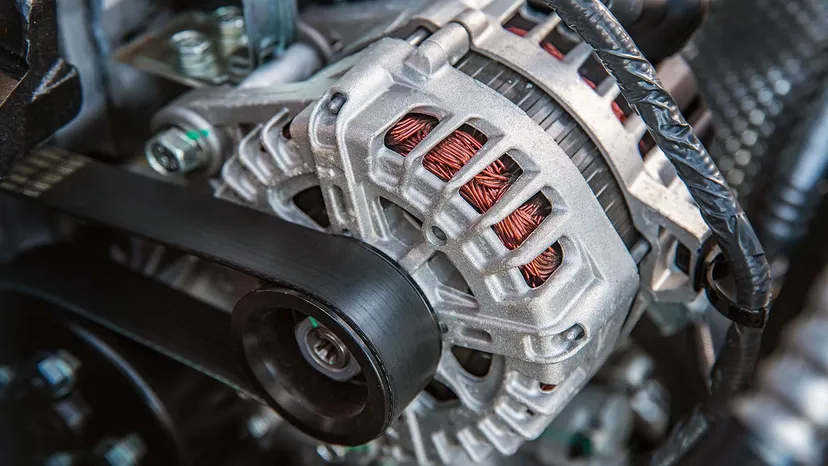A failing alternator can leave you stranded by not charging your car’s battery, powering lights, or running electronics. This guide is for DIY car owners with beginner to intermediate skills, detailing how to spot signs of alternator failure and test it at home. With step-by-step instructions, safety precautions, and practical tips, you’ll diagnose issues confidently for vehicles like a 2020 Toyota Corolla or 2018 Ford F-150, saving time and money.
Why Alternator Testing Matters
The alternator generates electricity to charge the battery and power systems while driving. A faulty one causes dead batteries (15% of breakdowns, per AAA), dim lights, or stalling, with repairs costing $200–$800, per automotive estimates. Ignoring issues risks engine damage ($1,000–$5,000) or towing ($50–$300). Testing takes 30–60 minutes and costs $10–$50 for tools, saving $100–$400 in shop diagnostics. Easier than replacement but requiring electrical care, it’s ideal for DIYers learning systems like those in a 2021 Honda Civic or 2019 Chevy Equinox.
By testing your alternator, you’ll catch failures early, ensure reliability, and avoid costly breakdowns.
Tools and Materials Needed
You’ll need these to test an alternator:
- Diagnostic Tools:
- Multimeter (digital, $10–$50, for voltage)
- Flashlight ($5–$15, for visibility)
- Owner’s manual (for specs, e.g., belt routing)
- Repair Tools:
- Wrench (10mm–13mm, $5–$20, for cables)
- Screwdriver (Phillips/flathead, $5–$10, for panels)
- Wire brush ($3–$5, for terminals)
- Safety Gear:
- Gloves (nitrile, $5–$10, for shocks)
- Safety glasses ($5–$10, for sparks)
- Optional:
- Battery tester ($10–$30, to rule out battery)
- OBD-II scanner ($20–$50, for codes)
- Belt tension gauge ($10–$30, for belt check)
- Rags ($3–$5, for cleanup)
- Electrical tape ($3–$5, for wires)
- Notebook ($2–$5, for logs)
Choose a reliable multimeter (e.g., Innova, AstroAI) with 0–20V DC range. Match tools to your car (e.g., 10mm wrench for a 2022 Nissan Altima’s battery). Quality brands (e.g., Craftsman, Klein) ensure accuracy over generics.
Safety First: Working with Alternators
Alternators involve electricity, moving belts, and batteries, posing risks. Follow these precautions:
- Turn Off the Engine: Remove keys unless testing requires running—belts snag ($50–$1,000 injury).
- Wear Protective Gear: Gloves and safety glasses prevent shocks or debris ($50–$500 medical).
- Disconnect Battery for Repairs: Remove negative (-) unless testing—sparks ignite ($500–$5,000).
- Avoid Water: Wet hands or surfaces increase shock risk, even at 12V ($50–$500).
- Don’t Touch Live Wires: Arcs damage alternators ($200–$800).
- Work in a Well-Lit Area: Use a flashlight—dim light causes errors ($5–$200).
- Keep Tools Insulated: Metal wrenches spark near terminals ($5–$50).
- Ventilate: Running engines produce fumes—open garage doors ($50–$500).
If new to electrical work, watch videos (e.g., “alternator test DIY”) and practice on a 9V battery. Keep a phone handy for specs or emergencies.
Step 1: Spotting Signs of Alternator Failure
Identify symptoms to confirm the alternator is the issue:
- Warning Lights:
- Check dashboard: “Battery” or “ALT” light on (e.g., 2020 Subaru Outback).
- Steady or flickering suggests charging failure ($200–$800).
- Electrical Issues:
- Dim headlights, weak wipers, or faint radio—low power ($50–$300).
- Test at night—dimming worsens with AC or heat on.
- Battery Problems:
- Slow cranks or dead battery after driving—alternator not charging ($100–$200).
- Recent battery replacement? Suspect alternator ($200–$800).
- Strange Noises:
- Whining or grinding from engine bay—bad bearings or loose belt ($50–$300).
- Listen near alternator (front, near belt).
- Stalling or Rough Running:
- Engine cuts out at idle or low power—insufficient charge ($200–$1,000).
- Noticeable in traffic or with electronics on.
- Smells or Heat:
- Burning rubber: slipping belt ($10–$50).
- Hot wire smell: overloaded alternator ($200–$800).
- Log Symptoms:
- Note details (e.g., “Dim lights, whines, 2021 Jeep Cherokee, Dec 2025”).
- Record when issues occur: cold start, highway, or idle.
Pro Tip: Use an OBD-II scanner ($20–$50) for codes (e.g., P0562, low voltage, $50–$800)—confirms electrical faults.
Step 2: Preliminary Checks
Rule out simple issues before testing:
- Inspect Battery:
- Check terminals for corrosion (white crust, $5–$50).
- Clean with wire brush, tighten with 10mm wrench.
- Test battery voltage (engine off):
- 12.5–12.8V: Good.
- Below 12.2V: Charge or replace ($100–$200).
- Check Belt:
- Locate alternator belt (serpentine, front of engine).
- Look for cracks, fraying, or glaze ($10–$50).
- Press midway—should deflect 0.5 inch, not loose/tight.
- Use gauge ($10–$30) for precision (e.g., 80–120 lbs tension).
- Examine Connections:
- Trace alternator cables (back of unit, 10mm–13mm bolts).
- Ensure tight, no frayed wires ($5–$50).
- Look for burn marks—overheating ($200–$800).
- Verify Fuses:
- Check manual (e.g., “ALT, 100A, engine bay” for 2019 VW Tiguan).
- Inspect for blown fuses—blackened or broken ($0.50–$5).
- Replace with same rating.
- Visual Inspection:
- Use flashlight—check alternator for leaks, cracks, or loose bolts.
- Spin pulley by hand (engine off)—should turn smoothly, no grind ($50–$300).
Note: Fix loose belts or cables first—may solve issues ($10–$50). Log findings (e.g., “Belt OK, loose terminal”).
Step 3: Testing the Alternator
Perform three key tests with a multimeter:
Test 1: Battery Voltage (Engine Off)
Checks if the battery holds charge.
- Setup:
- Set multimeter to 20V DC.
- Touch red probe to battery positive (+), black to negative (-).
- Engine off, key out.
- Read:
- 12.5–12.8V: Healthy battery—proceed.
- 12.2–12.4V: Charge 4–8 hours, retest.
- Below 12.2V: Replace battery ($100–$200)—not alternator yet.
- Fix:
- Charge or replace battery before alternator tests.
- Clean terminals again ($3–$5).
Example: Tom tests his 2022 Kia Sorento—12.6V, good to go.
Test 2: Charging Voltage (Engine Running)
Verifies alternator output.
- Setup:
- Start engine, idle (1000–1500 RPM).
- Set multimeter to 20V DC, probes on battery (+ red, – black).
- Turn on headlights for load.
- Read:
- 13.8–14.8V: Alternator works fine.
- Below 13.5V: Weak output—check belt, connections ($10–$50).
- 12.6V or less: Not charging—likely alternator ($200–$800).
- Above 15V: Overcharging, bad regulator ($50–$200).
- Load Test:
- Turn on AC, wipers, radio—voltage should stay 13.5–14.5V.
- Drops below 13V: alternator failing under load ($200–$800).
- Fix:
- Tighten belt or cables ($5–$50).
- If still low, alternator needs repair/replacement.
Example: Lisa’s 2020 Ram 1500 reads 14.2V idle, 13.8V loaded—normal.
Test 3: Diode Test (Ripple Check)
Detects faulty diodes causing AC leakage.
- Setup:
- Engine running, set multimeter to AC voltage (0–2V range).
- Probes on battery (+ red, – black).
- Read:
- Below 0.5V AC: Diodes good.
- Above 0.5V: Bad diodes—alternator failing ($200–$800).
- High AC dims lights or fries electronics ($50–$500).
- Fix:
- Replace alternator—diodes aren’t DIY-repairable ($200–$800).
Example: Mike’s 2019 Toyota RAV4 shows 0.3V AC—diodes OK.
Pro Tip: Retest at 2000 RPM—low output may show only at higher revs ($50–$200 savings).
Step 4: Interpreting Results and Next Steps
Analyze findings to act:
- Normal Readings:
- 12.6V off, 13.8–14.8V running, <0.5V AC: Alternator fine.
- Check battery, wiring, or accessories ($50–$300).
- Example: Dim lights may be bad bulbs ($10–$50).
- Low Output:
- Below 13.5V or no charge: Tighten belt ($10–$50), clean connections ($3–$5).
- Persistent: Replace alternator ($200–$800, 1–2 hours).
- Check regulator (some cars separate, $50–$200).
- Overcharging:
- Above 15V: Replace regulator or alternator ($50–$800).
- Stop driving—damages battery ($100–$200).
- Bad Diodes:
- High AC voltage: Replace alternator ($200–$800).
- Confirm with shop test if unsure ($50–$100).
- Drive Test:
- Drive 10–20 miles, monitor lights, gauge, or stalls.
- Battery light on or dimming: alternator failing ($200–$800).
- Retest voltage after 50 miles—confirms fix.
- Log Results:
- Note readings (e.g., “14.0V running, 0.4V AC, Jan 2026”).
- Save photos of setup for reference.
Note: Don’t drive with a dead alternator—battery drains in 30–60 minutes ($50–$300 towing).
Step 5: Maintaining Your Alternator
Prevent future issues:
- Check Belt Yearly:
- Inspect for wear, tighten if loose ($10–$50).
- Replace every 60,000 miles ($20–$100).
- Clean Connections:
- Brush terminals every 6 months—corrosion cuts output ($3–$5).
- Apply dielectric grease ($3–$5).
- Monitor Battery:
- Test voltage monthly—weak batteries strain alternators ($100–$200).
- Replace every 4–5 years.
- Inspect Wiring:
- Look for fraying yearly—tape small damage ($3–$5).
- Replace cables if burned ($10–$50).
Pro Tip: Run scanner monthly—catches low-voltage codes early ($50–$800 savings).
Common Mistakes to Avoid
- Wrong Mode: AC on DC fries multimeter ($10–$50).
- Live Repairs: Sparks ruin alternators ($200–$800).
- Ignoring Belt: Loose ones mimic failure ($10–$50).
- No Gloves: Shocks or burns ($50–$500).
- Skipping Battery Test: Dead battery misleads ($100–$200).
- Driving with Failure: Strands you ($50–$300).
When to Seek Professional Help
Most tests are DIY-friendly, but see a mechanic if:
- Persistent Low Output: After fixes, suggests wiring ($200–$1,000).
- Complex Removal: Tight alternators need tools ($200–$800).
- Electrical Shorts: Risk fires ($500–$5,000).
- Unsure Readings: Mixed results need oscilloscopes ($200–$1,000).
- Codes Persist: Scanner shows ECU faults ($500–$3,000).
Shops charge $100–$400 for diagnostics, but DIY saves with a multimeter.
Additional Tips for Alternator Health
- Test Monthly: Voltage checks catch issues ($0–$10).
- Keep Spares: Store belt, fuses ($10–$50).
- Check at Night: Dim lights show failures ($10–$50).
- Use Quality Parts: OEM alternators last longer ($200–$800).
- Monitor Loads: High stereo strains ($50–$300).
- Recycle Old Units: AutoZone takes alternators ($5–$20 credit).
Environmental and Cost Benefits
Testing prevents waste—a bad alternator (15 pounds) or battery (7 pounds) avoids landfills. It saves fuel by 2–5%, or 20–50 pounds of CO2 yearly, per EPA. DIY cuts $100–$400 per job, and a multimeter ($10–$50) lasts years. Recycling parts reduces pollution—one battery contaminates soil for decades.
Conclusion
DIY alternator testing lets you spot failures early, from dim lights to dead batteries, ensuring your car stays reliable. By checking voltage, belts, and diodes, you’ll diagnose issues confidently. This guide suits beginners to intermediates, while tips like logging readings or cleaning terminals help all DIYers.
Next, try tasks like battery maintenance or fuse checks to grow skills (see related guides). If problems persist, consult a mechanic. With $10–$50 in tools and an hour, you’re set for a powered-up ride!




